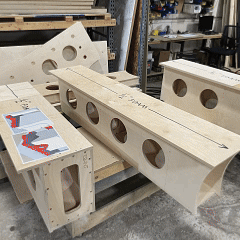CASE STUDY:
New York Small World features a social playscape for exploratory learning
June 05, 2025
By Efficiency Lab for Architecture
Designed by Efficiency Lab for Architecture, the New York Small World project is an interior renovation of the second floor of Avenues: The World School’s Chelsea, Manhattan building to expand its existing Daycare Center. At the heart of the newly transformed Small World level lies an interior Movement Room, an undulating playscape that encourages discovery, creativity, and exploration.
Photo © Inessa Binen Baum
To facilitate a more open flow through the Small World space, Efficiency Lab for Architecture reconfigured the floor layout. The central areas previously used as offices have been transformed into a playscape, while four classrooms are renovated with new lighting, millwork, and furniture to shape a more welcoming and functional learning environment. The classrooms are designed to integrate natural materials such as wood flooring. The walls are lined with tackable surfaces for children’s work to be displayed and to create an interactive learning space. The project scope totaled 4,345 sf and includes a new Movement Room, new restrooms, a new office, and updates to the existing classrooms and corridors.
Photo © Inessa Binen Baum
By strategically positioning the Movement Room at the center of the floor, the design maximizes the access for students in all classrooms and sets the stage for a more participatory learning.
“Designing for empathy has been a key concept for all our school projects,” says Aybars Asci, founder of Efficiency Lab for Architecture. “For New York Small World, we designed a fun environment for social learning through play.”
Photo © Inessa Binen Baum
The custom interior playscape is designed as an environment where children’s physical sensations can be fully engaged, allowing them to use their entire bodies and strengthen their muscles, through crawling, running, and jumping. Designed specifically for toddlers, an age during which children are actively developing their gross motor skills, the playscape allows children to test the physical limits of how far they can run, and how high they can climb and jump. The Movement Room is protective, yet encourages risk-taking, discovery, and creativity through play. The upholstered pieces form nooks and niches, curving around the corners and the columns of the space to support movement and experimentation. The children can rearrange many of the pieces to shape their own surroundings, allowing a sense of active participation and direct engagement.
Photo © Inessa Binen Baum
The geometry of the playscape is characterized by undulating forms that seamlessly transition from concave to convex, allowing children to have a fluidity of motion-ranges as they play in and around the Movement Room. At several moments, the rolling curves of the playscape wrap around to form egg-shaped niches. These looped spaces create a diversity of experiences by encouraging slower activity; they offer children a space to rest and hide within the flowing continuity of the playscapes which facilitates a faster pace movement.
As Asci explains, “The fluid geometric formations of the playscapes encourage children to develop a range of motions by interacting with the architecture.”
Efficiency Lab for Architecture’s custom playground system is designed specifically for interior play—with code compliant materials such as fully fire-retardant plywood, wrapped in impact resistant padding with high-grade, easily maintainable fabric.
Construction photo of play structure at SITU Fabrication
Another primary consideration in the design of the play environment was safety. All surfaces have a minimum padding layer of ½”. All of the vertical surfaces facing the movement area are covered in a minimum of 2”, which is industry standard for wall padding. In addition, the design uses a flooring mat that was tested to a 5-foot fall height—far exceeding any of the heights the children would be able to climb to within the play area.
Photo © Inessa Binen Baum
New York Small World is part of Efficiency Lab for Architecture’s longstanding work with Avenues: The World School, designing spaces for education around the world, contributing to research, and collaborating to develop learning environments of the future. Efficiency Lab for Architecture’s work ranges from master planning of campuses to furniture design, in New York, Silicon Valley, Miami, Shenzhen, and São Paulo





